TO
1 - 25 of 15
| Creator | Title | Description | Subject | Date | ||
|---|---|---|---|---|---|---|
| 1 |
 | Regehr, John | Poster abstract: TinyOS 2.1 adding threads and memory protection to tinyOS | The release of TinyOS 2.0 two years ago was motivated by the need for greater platform flexibility, improved robustness and reliability, and a move towards service oriented application development. Since this time, we have seen the community embrace these efforts and add support for additional hardw... | 2008-01-01 | |
| 2 |
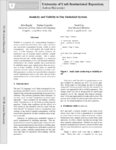 | Regehr, John | Atomicity and visibility in tiny embedded systems | Visibility is a property of a programming language's memory model that determines when values stored by one concurrent computation become visible to other computations. Our work exploits the insight that in nesC, a C-like language with explicit atomicity, the traditional way of ensuring timely visib... | 2006-01-01 | |
| 3 |
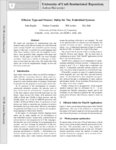 | Regehr, John | Efficient type and memory safety for tiny embedded systems | We report our experience in implementing type and memory safety in an efficient manner for sensor network nodes running TinyOS: tiny embedded systems running legacy, C-like code. A compiler for a safe language must often insert dynamic checks into the programs it produces; these generally make progr... | 2006-01-01 | |
| 4 |
 | Gopalakrishnan, Ganesh | Efficient search for inputs causing high floating-point errors | Tools for floating-point error estimation are fundamental to program understanding and optimization. In this paper, we focus on tools for determining the input settings to a floating point routine that maximizes its result error. Such tools can help support activities such as precision allocation, p... | 2014-01-01 | |
| 5 |
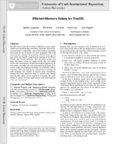 | Regehr, John | Efficient memory safety for TinyOS | Reliable sensor network software is difficult to create: applications are concurrent and distributed, hardware-based memory protection is unavailable, and severe resource constraints necessitate the use of unsafe, low-level languages. Our work improves this situation by providing efficient memory an... | 2007-01-01 | |
| 6 |
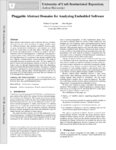 | Regehr, John | Pluggable abstract domains for analyzing embedded software | Many abstract value domains such as intervals, bitwise, constants, and value-sets have been developed to support dataflow analysis. Different domains offer alternative tradeoffs between analysis speed and precision. Furthermore, some domains are a better match for certain kinds of code than others. ... | 2006-01-01 | |
| 7 |
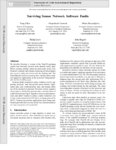 | Regehr, John | Surviving sensor network software faults | We describe Neutron, a version of the TinyOS operating system that efficiently recovers from memory safety bugs. Where existing schemes reboot an entire node on an error, Neutron's compiler and runtime extensions divide programs into recovery units and reboot only the faulting unit. The TinyOS kerne... | 2009-01-01 | |
| 8 |
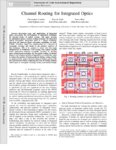 | Blair, Steven | Channel routing for integrated optics | Increasing scope and applications of integrated optics necessitates the development of automated techniques for physical design of optical systems. This paper presents an automated, planar channel routing technique for integrated optical waveguides. Integrated optics is a planar technology and lacks... | 2013-01-01 | |
| 9 |
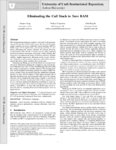 | Regehr, John | Eliminating the call stack to save RAM | Most programming languages support a call stack in the programming model and also in the runtime system.We show that for applications targeting low-power embedded microcontrollers (MCUs), RAM usage can be significantly decreased by partially or completely eliminating the runtime callstack. We presen... | 2009-01-01 | |
| 10 |
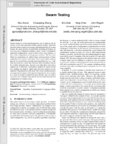 | Regehr, John | Swarm testing | Swarm testing is a novel and inexpensive way to improve the diversity of test cases generated during random testing. Increased diversity leads to improved coverage and fault detection. In swarm testing, the usual practice of potentially including all features in every test case is abandoned. Rather,... | 2012-01-01 | |
| 11 |
 | Bargteil, Adam Wade | Deformation embedding for point-based elastoplastic simulation | We present a straightforward, easy-to-implement, point-based approach for animating elastoplastic materials. The core idea of our approach is the introduction of embedded space-the least-squares best fit of the material's rest state into three dimensions. Nearest neighbor queries in the embedded spa... | 2014-01-01 | |
| 12 |
 | Bargteil, Adam Wade | Animation of deformable bodies with quadratic bézier finite elements | In this article, we investigate the use of quadratic finite elements for graphical animation of deformable bodies.We consider both integrating quadratic elements with conventional linear elements to achieve a computationally efficient adaptive-degree simulation framework as well as wholly quadratic ... | 2014-01-01 | |
| 13 |
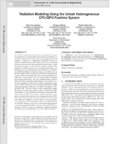 | Berzins, Martin | Radiation modeling using the Uintah heterogeneous CPU/GPU runtime system | The Uintah Computational Framework was developed to provide an environment for solving fluid-structure interaction problems on structured adaptive grids on large-scale, long-running, data-intensive problems. Uintah uses a combination of fluid-flow solvers and particle-based methods for solids, toget... | 2012-01-01 | |
| 14 |
 | Regehr, John | Volatiles are miscompiled, and what to do about it | C's volatile qualifier is intended to provide a reliable link between operations at the source-code level and operations at the memory-system level. We tested thirteen production-quality C compilers and, for each, found situations in which the compiler generated incorrect code for accessing volatile... | 2008-01-01 | |
| 15 |
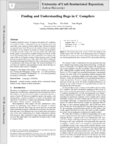 | Regehr, John | Finding and understanding bugs in C compilers | Compilers should be correct. To improve the quality of C compilers, we created Csmith, a randomized test-case generation tool, and spent three years using it to find compiler bugs. During this period we reported more than 325 previously unknown bugs to compiler developers. Every compiler we tested w... | 2011-01-01 |
1 - 25 of 15
